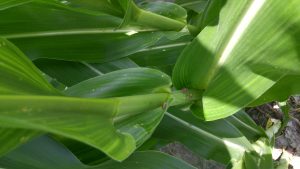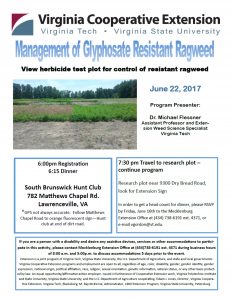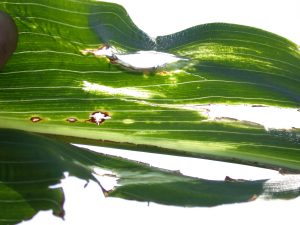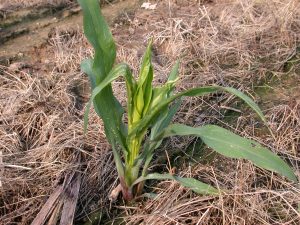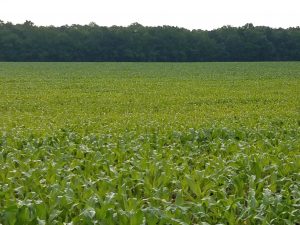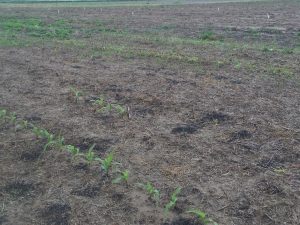Charlie Cahoon
Extension Weed Specialist, Virginia Tech
Warrant is an encapsulated formulation of the herbicide acetochlor and has widely become a part of our postemergence (POST) herbicide program in cotton. Although Warrant does not control emerged weeds, it does provide excellent residual control of pigweed, other small seeded broadleaves, and annual grasses (with the exception of Texas panicum). This makes it an excellent tank mix partner for glyphosate (Roundup) or glufosinate (Liberty) in our first, second, or both POST sprays, especially in fields heavily infested with glyphosate-resistant Palmer amaranth. However, because of its encapsulated formulation, Warrant can also be applied preemergence (PRE) to cotton. You may remember the days of using the EC formulation of acetochlor, known as Harness, in corn. This formulation was not encapsulated and significant injury would result if applied PRE or POST to cotton. This is not the case with Warrant. The encapsulated version affords much more cotton safety that the old EC formulation. In my experience, PRE applied Warrant has been very safe on cotton. As is the case with all residual herbicides, environmental conditions influence cotton response to PRE applied Warrant. Unfortunately, conditions we are currently experiencing in Virginia and northeast North Carolina; cool, wet soils and overall less than ideal weather for planting cotton are conducive to Warrant injury.
I saw this in my on research trials during the spring of 2016. Our cotton planted at the Tidewater AREC (near Holland, VA) on May 15, 2016 took approximately 9 days to emerge whereas cotton planted May 26, 2016 emerged in roughly 5 days. The weather was mostly to blame for the differences in vigor of the two plantings, but Warrant compounded the problem. So why the difference? We all know that cotton planted into cool wet soils is slow to emerge. Cotton tolerance to Warrant all hinges on the breakdown of the tiny capsules used to encapsulate acetochlor versus the time it takes for cotton to emerge. The key to avoiding injury from PRE applied Warrant is for cotton to emerge prior to the majority of these capsules breaking down and subsequent release of acetochlor.

Nontreated check plot.
Under ideal planting conditions this is not an issue. On the other hand, if cotton is slow to emerge, giving the capsules more time to breakdown and the seedlings have to push through a higher concentration of acetochlor, the potential for injury is greater. This is exactly what I saw in 2016 and have heard complaints about in years prior. Cotton that laid in the ground longer than usual and received Warrant PRE was stunted about 25%.
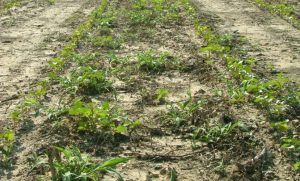
Weed control by Warrant alone.
My cotton eventually recovered and by the end of the season no yield differences were observed. Cotton that emerged quickly showed no injury in response to PRE applied Warrant and was one of the safest and cleanest treatments.
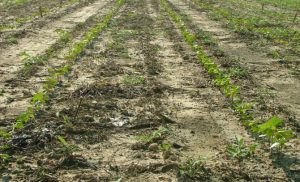
Weed control by Warrant plus 10 oz/A Reflex.
I routinely recommend Warrant PRE especially where Palmer pigweed is a problem. The fact is that all of our residual herbicides are capable of injuring cotton if the weather does not cooperate. As the planting progresses, I would advise you to factor in the planting conditions when choosing your PRE herbicides. Any conditions delaying emergence of cotton is conducive to injury from Warrant PRE. With that said, it may be wise to leave Warrant out of the tank until planting conditions improve. Do not let this stop you from using a residual herbicide all together. Alternatives to Warrant include Cotoran, Direx, Prowl, Reflex, and fluridone containing products (Brake FX and Brake F16). With all the herbicide resistance issues knocking on our door, it is imperative that we continue to use residual herbicides early burndown, around planting, and in-season. Once cotton land dries out and soil temperatures rise, Warrant will again be one of our best residual options.

